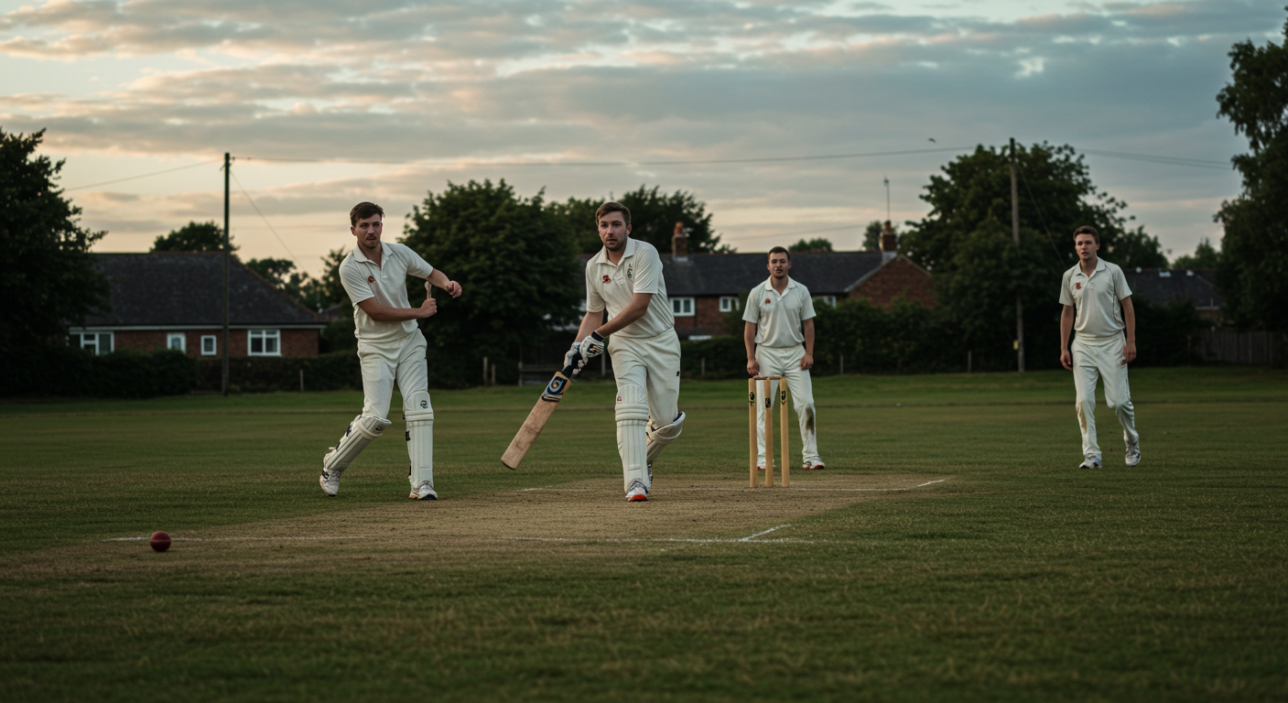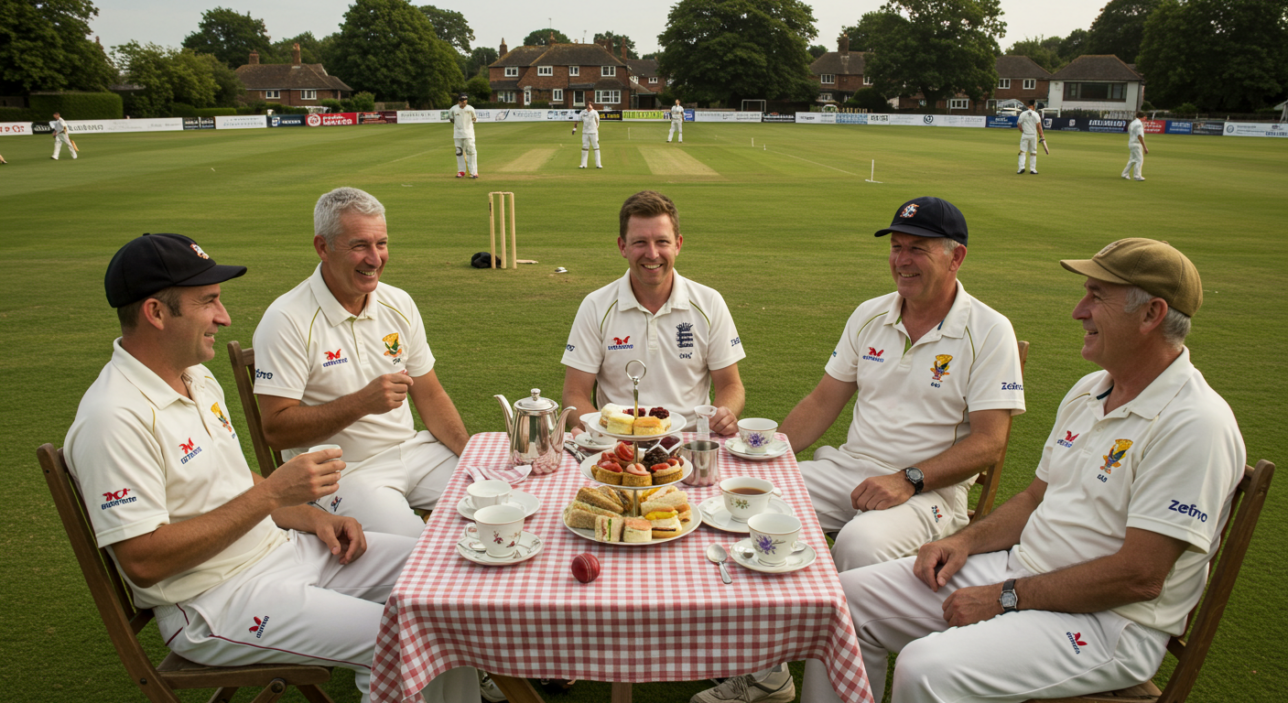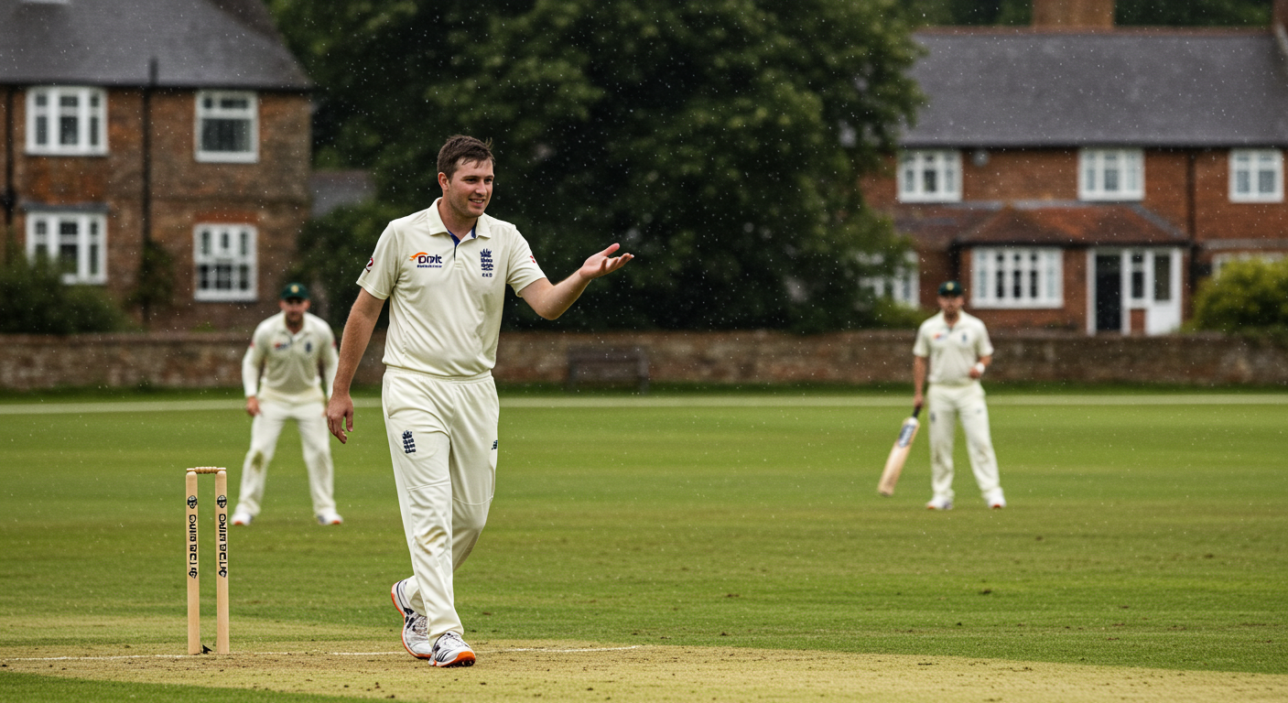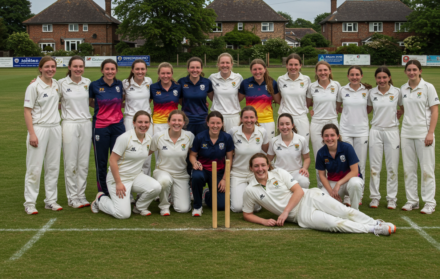
How Weather Shapes the Village Cricket Season
There’s a universal truth in village cricket: you’re never just playing against another team. You’re playing against the weather. Every fixture in the calendar, from the first over in April to the final desperate slog in September, has an uninvited third participant — the great British sky. It’s why the village fixture list is pencilled in, never inked. It’s why captains check weather apps more often than they check their batting averages.
How weather shapes the village cricket season isn’t just about whether the covers need pulling on or off. It shapes who turns up, what kind of cricket gets played, and whether a season is remembered for champagne moments or a dozen rain-ruined washouts. Rain cancels matches, yes, but even a good spell of sunshine can turn rock-hard outfields into injury traps and dusty wickets into minefields. A light drizzle can turn an even contest into a comedy of fielding errors. And a random 30-degree scorcher in July? That can send players wilting and pint sales soaring.
The charm of village cricket is that nobody can really control it. You can roll pitches, mow outfields, and plan your team strategy perfectly, but in the end, you’re at the mercy of whatever rolls in across the fields. The resilience built from decades of rained-off Sundays, surprise storms, and baking afternoons has shaped not just the game but the players too. Village cricket survives because its players know how to laugh at the weather — and turn up anyway.
1. The Pre-Season Gamble: April’s False Promises and Muddy Realities

Ask any village cricketer about April fixtures, and you’ll likely get a hollow laugh in response. Officially, April is the start of the season, marked by friendly matches and the first league games. Unofficially, it’s often four weekends of squinting at the sky, poking at boggy squares, and wondering whether you’re about to play cricket or water polo.
Pre-season in village cricket is a masterpiece of misplaced optimism. Fixtures are scheduled months in advance on the assumption that winter will release its grip in time. Groundsmen — heroic, stoic souls — work tirelessly to coax pitches into something playable, battling sodden soil, patchy grass, and broken mowers that have rusted over during the colder months.
Even when matches do go ahead, conditions are rarely ideal. Players run the risk of hamstring pulls from muddy outfields, while bowlers slip at the crease as they try to find traction on greasy grass. Batting, meanwhile, becomes an exercise in patience and survival, with balls keeping low, seaming unpredictably, or plugging on impact like shot-puts.
Still, there’s a peculiar romance to it. The first match of the year, however miserable the conditions, feels like a rite of passage. You survived the winter. You made it back onto the field. Even when it’s three jumpers under the whites and constant rain squalls from the west, players still turn up. Because they know, deep down, this is part of how weather shapes the village cricket season — unpredictable, uncomfortable, but undeniably part of what makes it worth loving.
2. Rain-Interrupted Matches: The Art of the Scramble
If there’s one thing guaranteed to unite cricketers and spectators alike, it’s the frantic scramble when rain starts falling mid-innings. Covers are dragged onto the square at record speeds, scorebooks are shoved under umbrellas, and players huddle miserably in pavilions clutching mugs of tea that taste suspiciously of damp wood.
Rain interruptions are a defining part of how weather shapes the village cricket season. Matches that start in bright sunshine can descend into chaos within minutes. Umpires make judgement calls based more on gut feeling than any scientific measurement of drizzle intensity. Captains nervously calculate reduced overs and minimum requirements for a match to count.
There’s a certain choreography to it all. Teams become adept at reading cloud movements like ancient mariners, debating whether a passing shower will clear in ten minutes or settle in for the afternoon. On days when everyone accepts that rain is inevitable, matches are often reduced to frantic T20-style slogs — wild swings, suicidal singles, and desperate attempts to post a score before the heavens open.
Despite the disruption, rain delays bring their own strange charm. It’s when lifelong friendships are forged over miserable cups of tea, and team legends are born from half-remembered tales told in draughty changing rooms. It’s also when optimism shines brightest: the firm belief that maybe the sun will come back out, and maybe you’ll get back on for just a few more overs. Because giving up completely just isn’t part of the village cricket DNA.
3. The Curse and Blessing of the Unexpected Heatwave

Every few summers, Britain experiences that rare phenomenon — a genuine heatwave. The kind that melts plastic boundary flags, wilts the umpire’s hat, and turns outfields into baked brown deserts. For village cricket, it’s both a blessing and a curse.
On one hand, heatwaves deliver glorious days where the sun blazes down, matches run uninterrupted, and post-game drinks stretch long into balmy evenings. Captains breathe a sigh of relief knowing they won’t be calling off fixtures for waterlogged pitches. Groundsmen cheer as they no longer have to battle endless damp. Batsmen love it too: hard, fast outfields and dry pitches reward good timing with boundaries galore.
But heat brings its own problems. Fields harden to the point where diving fielders risk more grazes and sprains than heroic saves. Bowlers, especially the fast ones, toil in unforgiving heat, their spells shortened to avoid heatstroke. Even batting becomes exhausting as kit drenches with sweat within the first few overs. By mid-afternoon, matches often slow to a crawl, as players search for shade between deliveries and the ball bounces erratically off cracked pitches.
Spectators suffer too, reluctantly swapping pints for bottled water as temperatures climb past comfort levels. Pavilion fridges struggle. Hats and sun cream become essential gear alongside bats and pads.
Still, when you look back at a season, it’s those endless sunny Saturdays that players remember most fondly. It’s another clear reminder of how weather shapes the village cricket season — unpredictable, often brutal, but occasionally perfect in its chaos.
4. Windy Days: The Invisible Saboteur
Rain gets the blame, heat gets the headlines — but wind? Wind is the sneaky villain of village cricket. It rarely cancels a match outright, but it makes everything harder, from bowling lines to beer tents staying upright.
For bowlers, it can be either an ally or a menace. A tailwind might give a seamer an extra yard of pace; a headwind, on the other hand, can make run-ups feel like trudging through sand. Spinners, especially the brave ones who toss it up into the breeze, watch their deliveries drift into entirely unplanned areas — sometimes straight into the next postcode.
Batting is no easier. Shots that would normally race to the rope suddenly hold up in the wind and get caught at mid-off. A mistimed hook might sail for six on one end, and then fall tamely into square leg’s hands when played the other way. Gloves become tricky too — a sudden gust mid-swing and the bat almost follows the ball.
Fielders get it worst. High catches swirl unpredictably like plastic bags in a supermarket car park. Calling for the ball becomes a gamble — you might be under it one second and six feet away the next. Scorebooks flap, sightscreens collapse, gazebo legs lift off like startled birds.
Wind might not stop play, but it certainly leaves its mark. It’s another unglamorous reminder of how weather shapes the village cricket season — less visible than rain, but just as capable of turning a good day into utter chaos.
5. Autumn Drift: When Light Fades and the Season Clings On

By late August and into September, every fixture starts to feel slightly borrowed — like squeezing in one last dance before the lights come on. The sun dips earlier, shadows stretch across the outfield, and players begin checking their watches more often than the scoreboard. Welcome to the fading twilight of the village cricket season.
Pitch conditions begin to shift again. The same track that baked and cracked under July heat now starts to soften in the early morning dew. Evening games become a race against time — especially on cloud-covered days when bad light becomes a frequent, muttered frustration.
Layers reappear. Thermals sneak under whites. Fingerless gloves come out of kit bags. And no one trusts the forecast anymore — it’s either wrong or far too optimistic. Even spectators seem more subdued, watching from their cars or clutching hot drinks from the bar with both hands.
Yet this part of the season brings its own kind of beauty. The pressure is often off. League tables are nearly settled, cups have been won or lost, and players savour every ball, knowing it could be the last they face for eight long months. Teas feel warmer, stories get longer, and those misty sunsets over the pavilion start to hit a bit differently.
It’s a melancholic but fitting reminder of how weather shapes the village cricket season — gradually drawing it to a close, with a chill in the air and a quiet nod to the passing summer.
6. Covers, Tarpaulins and the Ritual of Pitch Protection
No discussion about how weather shapes the village cricket season is complete without giving due respect to the humble pitch cover — or more often, the ancient tarpaulin sheet that smells faintly of diesel and despair. Dragging covers across a wicket isn’t just a practical task — it’s a ritual, a right of passage, and occasionally, a comedy act.
Every club has their own system. Some use proper wheeled covers with flaps, drains and ropes like a military operation. Others rely on a patchwork of canvas sheets, fraying ropes, and two blokes desperately trying to pin it down while the wind attempts to send it into orbit. Timing matters. Cover the pitch too early and it sweats into a sticky mess. Cover it too late and you may as well not have bothered.
When a rain shower hits mid-game, you see the club transform instantly. Players turn into ground staff, sprinting from pavilion to square, grabbing pegs and hammers like a village version of Gladiators. Once down, the inspection rituals begin. People poke at the covers with their toes. Others declare, with absolute confidence, “it’ll pass in ten minutes” — often without a single look at the sky.
Covering a pitch is more than just keeping it dry. It’s a symbol of hope — that cricket will go ahead, that the game matters enough to fight for. And it’s yet another way how weather shapes the village cricket season: by dragging every player, groundsman, and volunteer into a shared, muddy, rain-soaked battle against nature.
7. Teas, Delays and the Weather-Adjusted Social Calendar

When weather disrupts the play, it doesn’t just affect overs and outcomes — it changes the entire rhythm of village cricket’s social life. Matches might be called off or shortened, but the kettle still goes on, the cakes still come out, and the chairs in the pavilion still fill with people determined to salvage something from the day.
Some clubs have turned weather delays into an art form. A drizzle might lead to a bonus quiz round. A full rain-off becomes a spontaneous pub crawl. One abandoned game in Derbyshire famously turned into a charity bingo night that raised more than the season’s raffle total. It’s never just about the game — it’s about being there, come what may.
Teas, in particular, become the real highlight on grey days. Players who didn’t fancy batting suddenly come alive at the sight of lemon drizzle and sausage rolls. Matches reduced to ten-over slogs are still worth turning up for, because everyone knows the spread will be there regardless. At some clubs, the tea ladies (and gents) have seen more seasons than half the playing XI — and they know weather chaos just means longer queues at the table.
This side of the game is too often overlooked, but it’s crucial to how weather shapes the village cricket season. Rain doesn’t just rearrange fixtures — it shifts the day’s centre of gravity, from boundary ropes to teapots, reminding everyone that village cricket is as much about people as play.
Conclusion: How Weather Shapes the Village Cricket Season

British weather has long been the unruly umpire of village cricket — unpredictable, unreasonable, and completely beyond appeal. From soggy Aprils to scorching Julys, sudden downpours to blustery wind, it dictates everything from team selection to tea arrangements. You don’t just play cricket in the UK — you negotiate with the elements every weekend.
Yet oddly, that’s part of the game’s soul. The rituals around checking forecasts, dragging covers, sheltering under gazebos, and squeezing in overs before the next downpour aren’t just obstacles — they’re shared experiences that bind village cricketers together. They’re the stories you laugh about at the end of the season: the duck scored in a hurricane, the heroic innings under dark skies, the impromptu pub session when rain cancelled play.
Understanding how weather shapes the village cricket season is key to understanding the culture that keeps it alive. It’s a sport built not just on skill, but on patience, improvisation, and a deep, often absurd, commitment to playing a game that only works when the weather allows it — and persevering when it doesn’t.
Some matches are won by talent, others by timing. But many are simply lost to the sky. And that’s okay. Because in village cricket, showing up with your whites, your flask, and a healthy disrespect for the forecast is half the battle. Rain or shine, the game carries on — and that’s what makes it so beautifully British.





